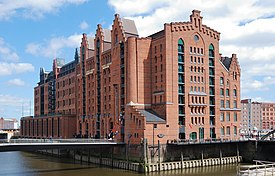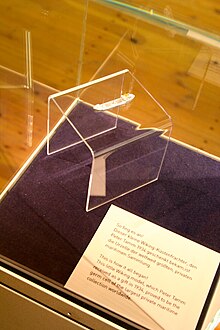
Hamburg, officially the Free and Hanseatic City of Hamburg, is the second-largest city in Germany, after Berlin, and 8th-largest in the European Union, with a population of over 1.9 million. The Hamburg Metropolitan Region has a population of over 5.1 million and is the ninth-biggest metropolitan region by GDP in the European Union.

Blohm+Voss (B+V), also written historically as Blohm & Voss, Blohm und Voß etc., is a German shipbuilding and engineering company. Founded in Hamburg in 1877 to specialise in steel-hulled ships, its most famous product was the World War II battleship Bismarck. In the 1930s, its owners established the Hamburger Flugzeugbau aircraft manufacturer which, shortly before the outbreak of World War II, adopted the name of its parent company. Following a difficult period after the war, B+V was revived, changing ownership among several owners, as Thyssen Group and Star Capital. In 2016, it became a subsidiary of Lürssen and continues to supply both the military and civilian markets. It serves two areas – new construction of warships as NVL B.V. & Co. KG, and new construction and refitting of megayachts. The company has been in operation, building ships and other large machinery, almost continuously for 147 years.

The Port of Hamburg is a seaport on the river Elbe in Hamburg, Germany, 110 kilometres (68 mi) from its mouth on the North Sea.

Elfriede Lohse-Wächtler was a German painter of the avant-garde whose works were banned as "degenerate art", and in some cases destroyed, in Nazi Germany. She became mentally ill and was murdered in a former psychiatric institution at Sonnenstein castle in Pirna under Action T4, a forced euthanasia program of Nazi Germany. Since 2000, a memorial center for the T4 program in the house commemorates her life and work in a permanent exhibition.

Hamburg was founded in the 9th century as a mission settlement to convert the Saxons. Since the Middle Ages, it has been an important trading center in Europe. The convenient location of the port and its independence as a city and state for centuries strengthened this position.

HafenCity is a quarter in the borough of Hamburg-Mitte, Hamburg, Germany. It is located on the Elbe river island Grasbrook, on the former Port of Hamburg area. It was formally established in 2008 and also includes the historical Speicherstadt area, which since 2015 is an UNESCO World Heritage Site with the adjacent Kontorhausviertel. The main landmark of the HafenCity is the Elbphilharmonie concert hall.

The Museum Godeffroy was a museum in Hamburg, Germany, which existed from 1861 to 1885.
Hamburger Hafen und Logistik AG, known until 2005 as Hamburger Hafen- und Lagerhaus-Aktiengesellschaft, and prior to that as Hamburger Freihafen-Lagerhaus Gesellschaft (HFLG) since 1885, is a German logistics and transportation company specialising in port throughput and container and transport logistics.

The Museum for Hamburg History is a history museum located in the city of Hamburg in northern Germany. The museum was established in 1908 and opened at its current location in 1922, although its parent organization was founded in 1839. The museum is located near the Planten un Blomen park in the center of Hamburg. The museum is commonly reviewed among the museums of the city of Hamburg.

The Elbphilharmonie, popularly nicknamed Elphi, is a concert hall in the HafenCity quarter of Hamburg, Germany, on the Grasbrook peninsula of the Elbe River.

Peter Tamm was a German journalist and collector. His collection formed the basis for the founding of Hamburg's International Maritime Museum in 2008.

The Speicherstadt in Hamburg, Germany, is the largest warehouse district in the world where the buildings stand on timber-pile foundations, oak logs, in this particular case. It is located in the port of Hamburg – within the HafenCity quarter – and was built from 1883 to 1927.

Überseequartier is a station on the Hamburg U-Bahn line U4. The station was opened in November 2012 and is located in the Hamburg quarter of HafenCity, Germany. HafenCity is part of the borough of Hamburg-Mitte. The station code is "UR".

HafenCity Universität is a rapid transit station on line U4 of the Hamburg U-Bahn network in the district of HafenCity in central Hamburg, Germany. The station is named after the nearby HafenCity Universität.

Steinwerder is a quarter of Hamburg, Germany in the borough Hamburg-Mitte on the southern bank of the river Elbe. It is a primarily maritime industrial location, with a resident population in 2017 of only 39.
Volker Hinz was a German photographer. Early in his career he became known for his political reportage and travel stories; now his portraits of artists, authors, fashion designers, sports men and politicians are better known.

Wilhelm Emil Meerwein was a German architect and politician.

Bernhard Georg Jacob Hanssen (1844–1911) was a German architect and politician.

The Speicherstadtrathaus is the administration building of Hamburger Hafen und Logistik AG. It is located in the historic warehouse complex of the Speicherstadt in the Port of Hamburg, Hamburg, Germany. The Speicherstadtrathaus has been a listed building since 1991 and has been on the UNESCO World Heritage List since July 5, 2015, along with the neighboring Kontorhaus District.
Elisabeth von Dücker was a German art historian. She worked as curator at the Altonaer Museum and at the Hamburg Museum der Arbeit. The themes of her exhibition projects were city history and women's work. She founded the “FrauenFreiluftGalerie Hamburg” in 1994.


























